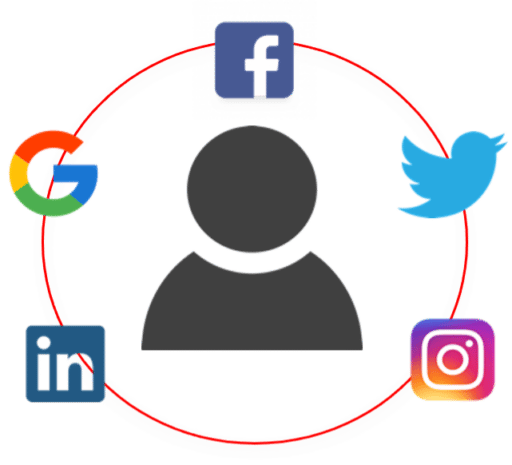Perhaps you remember when there was a world without the internet and computers, where countless school lessons and typing exams could make even the youngest head turn gray? Or maybe you remember when cell phones were for the few who proudly lugged around the 5 kg "brick" of a so-called portable phone? I can't...
But I meet many managers who have grown up in a time without the internet and digital media, who try to keep up and utilize the possibilities of new technology, but find it difficult. We probably all know the person who doesn't have any faith in digital media. Maybe you're even that person yourself.
What if I told you that of your younger employees between the ages of 25 and 35, only 6% are not present on social media, and that number is down to 2% if we look at 16-24 year olds? Does this still have no impact on the way you as a manager approach and work with your digitally native employees?
"The digital natives"
The digital natives, or Generation Z as they are also known, are people born from 1990 (Shcultz Hansen, 2015). They have grown up in a time when 24-hour internet access has become a matter of course. As Marianne Levinsen from the Center for Futures Research defines the new generation, the term "digital natives" means that they have grown up in the digital universe and have no concept of a world without digital platforms (Levinsen, 2015). In other words: What cannot be found digitally does not exist at all!
But what impact does the entry of digital natives into the labor market have on the way you act as a manager? This is a question that business researcher Søren Schultz Hansen has been studying for the past nine years. One of the most interesting observations he has made, to my mind, is the distinction between 'presence' and what he calls 'present' (Schultz Hansen, 2015). Presence is about being present and present in physical form as a leader. This behavior is widely known in management literature and is put into practice through, for example, ongoing 1:1 dialogues, daily physical 'touch-points', department meetings, etc. The point is that digital natives prefer present leadership to present management. In his definition of the concept of present leadership, Søren Schultz Hansen describes four key factors that apply. In short, present leadership is about:
- "Presence" rather than "presence": Presence is about leadership being something that unfolds in time rather than space. This also means that as a leader, you don't have to be physically present - as long as you are present for employees through Snapchat, Facebook chat, Instagram or other social media.
- Openness and transparency: Digital natives prefer open and transparent group dialogues about performance and development. At the same time, confidential and personal one-on-one meetings with managers are less valued. Many of the younger employees prefer conversations where more people participate in the dialog. In practice, closed Facebook groups with employees can be an effective tool to meet the expectations of digital natives for increased openness and transparency.
- Recognize, recognize, recognize: digital natives have grown up in a world where they're used to getting recognition and feedback on EVERYTHING they do. This expectation doesn't disappear just because they join your organization. You'll have to deal with it as a leader. Leaders who believe that "praise and recognition should be well-deserved - I don't give praise unless I really think it's an extraordinary presentation" may be setting themselves up for failure when dealing with digital natives. This will give digital natives the perception that your organization or department is a "recognition-free zone", which will affect the way they see you as a leader, but also your organization and their own engagement and well-being (Schultz Hansen, 2015).
- Quick feedback: Even if you as a leader are able to give your digitally native employees feedback and recognition for everything they do - it's not enough. There is also a speed component to the concept of present leadership. This means that there will be a correlation between time and the value of your feedback; the longer it takes from the time the digital native performs an action that should trigger feedback or recognition to the time you, as a manager, deliver that feedback or recognition, the value of your feedback will decrease. If too much time passes, the digital native will have moved on and your good intentions will be lost (Schultz Hansen, 2015).
The point I will make in the rest of this article is that the use of social media can be a crucial key to success in the transition from present leadership to present leadership. I would venture to say that you must use social media as a leadership space in order to succeed as a leader in a digitalized world.
As many as 98% of young Danes between the ages of 16 and 24 use social media, such as Facebook, Snapchat, Instagram and Twitter, while the same figure is 94% for the 25-35 age group (Statistics Denmark, 2017).
This is the overall picture that is already starting to emerge of your workforce, and in just a few years, will be very much a characteristic of much of your workforce as digital natives enter your organization.

Social media is already an integral part of the digital natives' everyday lives, and its use is almost taken for granted as a prerequisite for being in the world at all. What would happen if you, as a manager, started "speaking the language of the digital natives" and began to see and use the opportunities that social media can bring to their day-to-day management?
Social media such as Snapchat, Facebook, LinkedIn and Instagram. Snapchat, Facebook, LinkedIn and Instagram are exceptional tools for meeting digital natives' expectations and desire for instant feedback - all the time. It takes two seconds to "like" your employee's latest status update on Facebook or share your team's hard work on a strategically important project with the world on LinkedIn. But it means a lot to the individual employee when you actually do it!
At the same time, social media allows you as a manager to establish an open and transparent dialog with your employees, where others can jump in and join the dialog. The now wide range of social media channels such as Zoom, Facetime, Yammer, Whatsapp and Skype also offer the opportunity to meet your employees in real time, regardless of physical presence. These options are, in my opinion, an overlooked tool for ensuring effective meetings within the individual department as well as across departments.
And with notifications popping up and indicating activity on your social media apps, social media can be a direct gateway to providing present leadership, where you as a manager are able to be present with your employees - just as if you passed each other in the hallway on the way into the office or met at the coffee machine.
In short, social media represents a number of levers that you as a manager can apply in your management practice when working with your digitally native employees (and soon your digitally native managers)...
Your digital presence as a leader becomes just as important as your physical presence. But the paradox is that the digital presence as a leader has a negligible place in mainstream leadership literature and existing HR practices. Here, it is common practice to continuously evaluate the leader's physical leadership through more or less comprehensive leadership evaluations of both a quantitative and qualitative nature. It is also common knowledge that management evaluations are a recognized and effective management and development tool that can contribute to the organization's strategy implementation in the managers' everyday lives (Bäckström, 2015). At the same time, it is also no news that one of the basic prerequisites for successful leaders is continuous constructive feedback (Eichinger & Lombardo, 2000). So what makes us think that evaluating and getting feedback on your digital presence as a leader is not also crucial?
SoMe360 - an evaluation of digital presence
Finally, I'd like to introduce you to what I call a SoMe360. This is an evaluation of your digital presence as a leader and your organization's digital presence across digital platforms: Google, Instagram, Twitter, LinkedIn and Facebook.
Through SoMe360, you can identify both strengths and development potential associated with your own and your organization's digital presence. Based on this analysis, you can then work on what a future strategy for the digital presence could look like to support the delivery of the core task.

Through SoMe360, you can identify both strengths and development potential associated with your own and your organization's digital presence. Based on this analysis, you can then work on what a future strategy for the digital presence could look like in order to investigate the solution of the core task. So, it's not just about you and your management - it's just as much about the outside world and the way your organization approaches citizens, businesses and other stakeholders in the work of solving the core tasks. In other words, as a manager, you are responsible for:
- Your personal digital presence AND
- The organization's digital presence.
These are the two dimensions we work with in a SoMe360. The hallmark of working with both is that your level of social media competence sets the standard for how well you and your organization are able to succeed with the core task through digital presence.
Summarizing
Digital natives are already entering the workforce, and you will see a significant increase in the number of digital natives in your organization in the coming years.
The vastly different world that digital natives have grown up in places new demands and expectations on you as a leader. To meet these expectations, you as a digital immigrant will need to rethink your leadership practices and expand your leadership repertoire.
This is where the use of social media becomes crucial to your success as a manager in working with your digital natives. I would even go so far as to say that when it comes to digital natives, your absence on social media is the equivalent of walking right past one of your employees in the hallway without so much as a glance.
Social media is an extraordinary management tool:
- Meet your younger employees' demands for instant feedback and recognition - all the time.
- Establish an open and transparent dialog with your employees where others can jump in and join the conversation.
- Be present and practice present leadership.
- Work systematically to solve the core task through both your personal digital presence as well as your organization's digital presence.
- So how long do you as a leader dare to disregard the use of social media as a management tool and continue to rely on what "usually works"?

Sign up for our hybrid leadership course
The course "Leading Virtual and Hybrid Work Communities" offers the special focus and action areas of this form of leadership and provides participants with concrete, proven tools for good leadership.
Your benefits:
- Tools for virtual facilitation
- The methods to create real social wellbeing through hybrid leadership
- The methods to increase productivity through hybrid management
- The 6 essential management tools
- Tools for collegial support, guidance and competence development through hybrid leadership
Close connection between theory and your everyday life
The course is based on a link between theory and practice. We ensure that both you and your organization experience a tangible impact when you return to your daily tasks with hybrid leadership.




